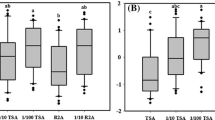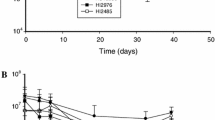Abstract
In order to verify whether the sterilization process of 60 min at 100°C for invert sugar 20% is sufficiently effective to attain the generally accepted probability of survival of maximum 1×10−6, we determined the bioburden and the bioburdens heat resistance for this product.
We examined 98 bottles by the membrane filtration method and found 84 bottles with o colony forming units (CFU's) and 14 bottles with 1–9 CPU's. Because none of the isolated CPU's was heat resistant (Bacillus species), we isolated heat resistant CPU's from the environment and determined the heat resistance in invert sugar, water and NaCl solution 0.9% of four differentBacillus species. The results in invert sugar for the most heat resistantBacillus species were a D-value of 0.92 min at 100°C.
For the determination of the D-value the end-point method is the most practical one, and the D-value calculation with the most probable number method is sufficiently accurate. Because of unavoidable inaccuracies in the experimentally determined D-value, safety margins of 100% have to be taken into account in the sterilization process calculations in which these D-values are used. Hence, in our case, we have to use a D-value of 2×0.92 min in the sterilization process calculation for invert sugar 20%.
The maximum bioburden in the examined 98 test bottles was 9 CFU's. The maximum heat resistant bioburden which must be used in sterilization process calculations may be safely fixed at 10% of the total bioburden, therefore we have to use 0.9 micro-organisms in our calculation. Hence using these values of 0.9 microorganisms and the maximum bioburden heat resistance (D-value=2×0.92 min at 100°C), the minimum sterilization process time for invert sugar 20% in our hospital pharmacy is calculated to be 10.96 min at 100°C.
Similar content being viewed by others
References
Nederlandse Farmacopee, Ed. VIII. 's-Gravenhage: Staatsuitgeverij, 1978:344–5.
British Pharmacopoeia. Cambridge: University Press, 1980:A196.
United States Pharmacopeia, Ed. XX. Easton: Mack Publishing Company, 1980:1037.
Food and Drug Administration. Current Good Manufacturing Practice in Manufacturing Processing, Packing or Holding of Large Volume Parenterals. Federal Register 1976:41(no. 106):22208.
Parenteral Drug Association. Technical Monograph no. I: Validation of steam sterilization cycles, 1978:1–36.
Van Asten J, Dorpema JW. A new approach to sterilization conditions. The IMO concept. Pharm Weekbl [Sci] 1982;4:49–56.
Boom FA, Paalman ACA. Microbiologische aspecten van het steriliseren van geneesmiddelen door middel van hitte. 1. Het afsterven van micro-organismen onder invloed van vochtige hitte. Pharm Weekbl 1979;114:157–65.
Wallhäusser KH. Sterilization-Desinfektion-Konservierung. 2nd ed. Stuttgart: Georg Thieme Verlag, 1978:204.
Caputo RA, Odlang TE, Wilkinson RL, Mascoli CC. Biological validation of a sterilization process for a parenteral product-fraction exposure method. J Parenter Drug Assoc 1979;33:214–21.
Tromp ThFJ. Autoclavering, microbiologische aspecten. Pharm Weekbl 1980;115:142–9.
Russel AD. The Destruction of Bacterial Spores. In: Hugo WB, ed. Inhibition and Destruction of the Microbial Cell. London-New York: Academic Press, 1971:451–612.
Gould GW. Methods for studying Bacterial Spores. In: Norris JR, Ribbons DW, eds. Methods in Microbiology. Part VIA. London-New York: Academic Press, 1971:327–81.
Briggs A. The resistance of spores of the genusBacillus in phenol, heat and radiation. J Appl Bacteriol 1966;29:490–504.
Jones AT, Pflug IJ.Bacillus coagulans, FRR B666, as a potential biological indicator organism. J Parenter Sci Technol 1981:35:82–7.
Reich RR.Bacillus stearothermophilus spores suspensions: effect of storage conditions and time on viability and moist heat resistance. J Parenter Sci Technol 1981;35:74–7.
Friesen WT, Anderson RA. Effects of sporulation conditions and cation-exchange treatment on the thermal resistance ofBacillus stearothermophilus spores. Can J Pharm Sci 1974;9:50–3.
Holcomb RG, Pflug IJ. The Spearman-Karber Method of analyzing quantal assay microbial destruction data. In: Pflug IJ, ed. Microbiology and engineering of sterilization processes. Philadelphia: Parenteral Drug Association Inc., 1978:75–92.
Pflug IJ. Heat Sterilization. In: Philips GB, Miller WS, eds. Industrial Sterilization. Durham NC: Duke University Press, 1973:239–82.
Strumbo CR, Murphey JR, Cohren J. Nature of thermal death time curves for P.A. 3679 andClostridium botulinum. Food Technol 1950;9:321–6.
Boom FA. Microbiologische contaminatie tijdens de bereiding van parenteralia. Pharm Weekbl 1980;115:170–81.
Boom FA, Graatsma BH, Oremus EThHGJ. Bereiding van parenteralia in ziekenhuisapotheken. III. Toetsing aan de hand van het produkt. Pharm Weekbl 1981:116:724–30.
Kooiman WJ, Geers JM. Simple and accurate technique for the determination of heat resistance of bacterial spores. J Appl Bacteriol 1975;38:185–9.
Brown MRW, Gilbert P. Increasing the probability of sterility of medical products. J Pharm Pharmacol 1977:29:517–23.
Whyte W, Baily PV, Tinkler J. An evaluation of the routes of bacterial contamination occurring during aseptic pharmaceutical manufacturing. J Parenter Sci Technol 1982:36:102–8.
Buchanon RE, et al., eds. Bergey's Manual of Determinate Bacteriology. 8th ed. Baltimore: The Williams & Wilkens Company, 1974:529–50.
Pflug IJ, Smith GM. Survivor Curves of Bacterial Spores heated in Parenteral Solutions. In: Pflug IJ, ed. Micro biology and engineering of sterilization processes. Philadelphia: Parenteral Drug Association Inc., 1978:17–57.
Anderson RA, Friesen WT. The thermal resistance ofBacillus stearothermophilus spores. The effects of temperature and pH of the heating medium. Pharm Acta Helv 1974:49:295–8.
Pflug IJ, Smith GM, Scheyer M, Chapman PA. Thermal resistance ofBacillus stearothermophilus spores suspended in parenteral solutions. Bull Parenter Drug Assoc 1976;30:128–38.
Härnulv BG, Snygg BG. Heat resistance ofBacillus subtilis spores at various water activities. J Appl Bacteriol 1972;35:615–24.
Gautier CA, Smith GM, Pflug IJ. Effect of fosfate buffer concentration on the heat resistance ofBacillus stearothermophilus spores suspended in parenteral solutions. Appl Environmental Microbiol 1978;36:457–64.
Reich RR, Whitbourne JE, McDaniel AW. Effect of storage conditions on the performance ofBacillus stearothermophilus biological indicators. J Parenter Drug Assoc 1979;33:228–34.
Heintz MT, Urban S, Schiller J, Gay M, Bühlmann X. The production of spores ofBacillus stearothermophilus with constant resistance to heat and their use as biological indicators during the development of aqueous solution for injection. Pharm Acta Helv 1976;51:137–43.
Author information
Authors and Affiliations
Rights and permissions
About this article
Cite this article
Boom, F.A., Paalman, A.C.A. & Stout-Zonneveld, A. Microbiological aspects of heat sterilization of medicines. Pharmaceutisch Weekblad Scientific Edition 6, 209–215 (1984). https://doi.org/10.1007/BF01999944
Received:
Accepted:
Issue Date:
DOI: https://doi.org/10.1007/BF01999944




